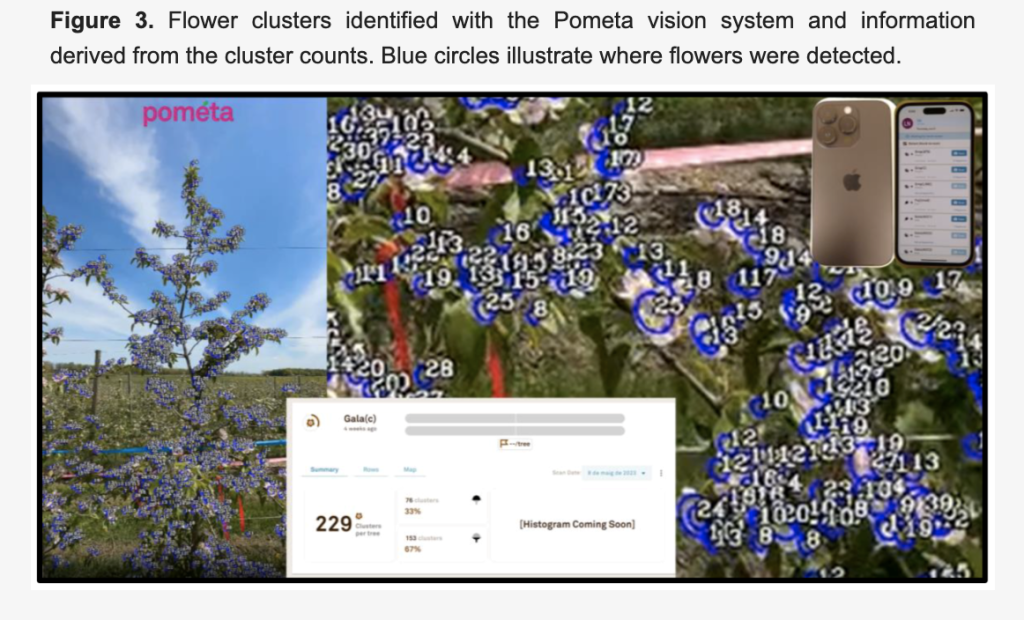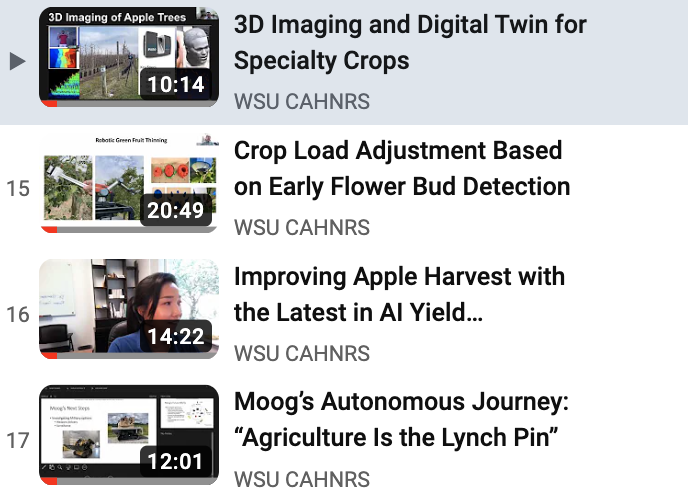The agriculture industry is hoping that more modern technology can make a big difference in productivity.
Listen on Marketplace Morning Report (December 27, 2023)
The agriculture industry is hoping that more modern technology can make a big difference in productivity.
Listen on Marketplace Morning Report (December 27, 2023)
Kate Prengaman // December 11, 2023
The first time I watched a camera sensor scan an orchard row and size every apple, I was amazed. The second time, I wondered what the value of such data would be to the grower.
Turns out, I’m not the only one wondering.
Growers and tech developers don’t always know, either.
Read full story here from GoodFruit Grower here…

Please help us gauge adoption but completing this survey, created by Mauricio Guerra Funes, a PhD student with Dr. Miguel Gomez in the Charles H. Dyson School of Applied Economics and
Management at Cornell University. You can reach Mauricio at mg2344@cornell.edu.
Below is the active formal survey link:
https://cornell.ca1.qualtrics.com/jfe/form/SV_bxXH5orx3GwZD6u

by Luis Gonzalez Nieto, Anna Wallis, Jon Clements, Mario Miranda Sazo, Craig Kahlke, Thomas M. Kon, and Terence L. Robinson
Edited by Mike Basedow, the full original article can be accessed here.
Precision crop load management of apple requires measuring trunks, counting flowers, fruitlets, or fruit at various times during the year to guide management decisions. While previous studies have found ways to incorporate these manual measurements into helpful orchard tools, time has often been a limiting factor in the adoption of these practices. There are an increasing number of tech companies working in agriculture that are incorporating these models into their portfolio. Our hopes are that the time required to collect the necessary data can be minimized so that more growers can have actionable information to manage their orchard more precisely.
Read more on Mike Basdedow’s blog here…

“Agtech, short for agriculture technology, is a growing industry that’s using data tools and software to help farmers improve yields and use fewer resources.
“With population growth increasing the global demand for food and climate change hurting crop yields, a swift adoption of agtech may be needed now more than ever. Yet, farmers are hesitant about embracing these new technologies.
“What’s in the way of farmers quickly adopting agtech, and how can the industry get more farmers on board?
“Marketplace” host Kai Ryssdal talked to reporter Belle Lin from the Wall Street Journal about her recent article on why so few farmers are using agtech. Below is an edited transcript of their conversation.”
Read the full Marketplace interview here…https://www.marketplace.org/2023/08/30/why-arent-farmers-using-new-tech/
Also, America’s Farmers Are Bogged Down by Data
“Uptake of agtech tools has been tepid, and even many farmers who do use them struggle with the software and a flood of data from their farms” from the Wall Street Journal, read the full here…https://www.wsj.com/articles/americas-farmers-are-bogged-down-by-data-524f0a4d

by Luis Gonzalez Nieto 1, Anna Wallis 2, Jon Clements 3, Mario Miranda Sazo 4, Craig Kahlke 4, Thomas M. Kon 5 and Terence L. Robinson 1
1 Horticulture Section, School of Integrative Plant Science, Cornell University, Geneva, NY 14456, USA
2 Extension Section, Michigan State University, Grand Rapids, MI 49503, USA
3 UMass Extension Section, University of Massachusetts, Belchertown, MA 01007, USA
4 Cornell Cooperative Extension, Lake Ontario Fruit Program, Albion, NY 14411, USA
5 Mountain Horticultural Crops Research and Extension Center, Department of Horticultural Sciences, North Carolina State University, Mills River, NC 28759, USA
Horticulturae 2023, 9(8), 880; https://doi.org/10.3390/horticulturae9080880
Precision crop load management of apple requires counting fruiting structures at various times during the year to guide management decisions. The objective of the current study was to evaluate the accuracy of and compare different commercial computer vision systems and computer applications to estimate trunk cross-sectional area (TCSA), flower cluster number, thinning efficacy, and yield estimation. These studies evaluated two companies that offer different vision systems in a series of trials across 23 orchards in four states. Orchard Robotics uses a proprietary camera system, and Pometa (previously Farm Vision) uses a cell phone camera system. The cultivars used in the trials were ‘NY1’, ‘NY2’, ‘Empire’, ‘Granny Smith’, ‘Gala’, ‘Fuji’, and ‘Honeycrisp’. TCSA and flowering were evaluated with the Orchard Robotics camera in full rows. Flowering, fruit set, and yield estimation were evaluated with Pometa. Both systems were compared with manual measurements. Our results showed a positive linear correlation between the TCSA with the Orchard Robotics vision system and manual measurements, but the vision system underestimated the TCSA in comparison with the manual measurements (R2s between 0.5 and 0.79). Read more here…

Harry Freeman1, Mohamad Qadri1, Abhisesh Silwal1, Paul O’Connor2, Zachary Rubinstein1, Daniel Cooley2, and George Kantor1
1Carnegie Mellon University Robotics Institute, PA, USA
2University of Massachusetts Amherst Stockbridge School of Agriculture, MA, USA
Abstract – Measuring growth rates of apple fruitlets is important because it allows apple growers to determine when to apply
chemical thinners to their crops to optimize yield. The current
practice of obtaining growth rates involves using calipers to
record sizes of fruitlets across multiple days. Due to the number
of fruitlets needed to be sized, this method is laborious, timeconsuming, and prone to human error. In this paper, we present
a computer vision approach to measure the sizes and growth
rates of apple fruitlets. With images collected by a hand-held
stereo camera, our system detects, segments, and fits ellipses to
fruitlets to measure their diameters. To measure growth rates,
we utilize an Attentional Graph Neural Network to associate
fruitlets across different days. We provide quantitative results on
data collected in an apple orchard, and demonstrate that our
system is able to predict abscise rates within 3% of the current
method with a 7 times improvement in speed, while requiring
significantly less manual effort. Moreover, we provide results on
images captured by a robotic system in the field, and discuss the
next steps to make the process fully autonomous.
Read more here…

Anna Wallis, Jon Clements, Mario Miranda Sazo, Craig Kahlke, Karen Lewis, Tom Kon, Luis Gonzalez, Yu Jiang and Terence Robinson
Reprinted from Fruit Quarterly, Volume 31, Number 1, Spring 2023
Decades of work have demonstrated that PACMAN (Precision Apple Crop load MANagement) is an extremely effective method for successfully managing crop load. Effective crop load management has a direct effect on yield, quality, size, and return bloom, and ultimately an orchard’s profitability. The process involves three management practices: 1) pruning, 2) chemical thinning, and 3) hand thinning, which have been described in detail in previous articles (Robinson et al., 2014a,b). We are continuing to refine recommendations for PACMAN, on a regional basis, as part of a 4-year national project, funded by the USDA-NIFA SCRI. This article is a follow-up to our previous article summarizing earlier work on this project (Robinson et al., 2022).
Full article below:
The last of the PACMAN show & tell’s are posted on the WSU CAHNRS YouTube channel here: https://www.youtube.com/playlist?list=PLajA3BBVyv1zc9xkiCSPqj3rEjW2vJ4Yb These now include updates from the PACMAN engineering team, including:
14 – 3-D Imaging and Digital Twin for Specialty Crops (Yu Jiang, Cornell University)
15 – Crop Load Adjustment Based on Early Flower Detection (Long He, Rashmi Sahu, and Paul Heinemann, Penn State)
16 – Improving Apple Harvest with the Latest in AI Yield Estimation for Specialty Crops (Dana Choi, University of Florida)
17 – Moog’s Autononmous Journey: “Agriculture is the Lynch Pin” (Chris Layer and Tom Fischer, Moog, Inc.)

March 9 @ 9:00 am – 11:00 am (Pacific Time)
This session provides updates on engineering-related research that looks to the future for apple crop load management. See what is being developed for further sensing and automation to assist with orchard production. Presentations are provided by researchers at Cornell University, Penn State, University of Florida, and Moog, Inc. These will be in a short 10-minute format, with time for questions and discussions at the end.
Introduction
Karen Lewis, Agriculture and Natural Resources Program Unit Director, Tree Fruit Extension Specialist, Washington State University
3D Imaging and Digital Twin for Specialty Crops
Yu Jiang, Assistant Research Professor, Agritech, Cornell University
Crop Load Adjustment Based on Early Flower Bud Detection
Long He, Assistant Professor of Agricultural and Biological Engineering, Rashmi Sahu, Graduate Student Paul Heinemann, Professor of Agricultural and Biological Engineering, Penn State
Improving Apple Harvest with the Latest in AI Yield Estimation for Specialty Crops
Dana Choi, Assistant Professor of Agricultural Engineering, University of Florida
Moog’s Autonomous Journey: “Agriculture Is the Lynch Pin”
Chris Layer, Mgr. Technology & Advanced Pursuits, and Tom Fischer – Moog Inc.